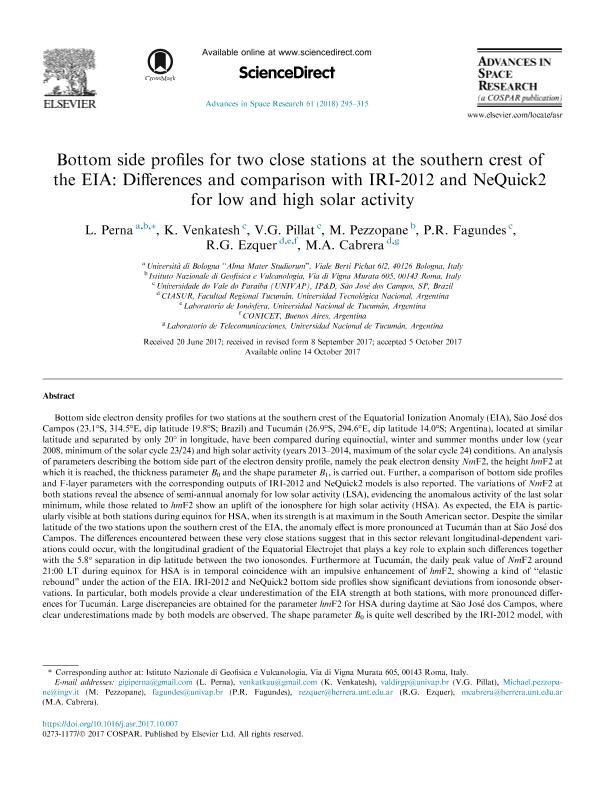Mostrar el registro sencillo del ítem
dc.contributor.author
Perna, Luigi
dc.contributor.author
Venkatesh, Kavutarapu
dc.contributor.author
Pillat, Valdir Gil
dc.contributor.author
Pezzopane, Michael
dc.contributor.author
Fagundes, Paulo Roberto
dc.contributor.author
Ezquer, Rodolfo Gerardo

dc.contributor.author
Cabrera, Miguel Angel

dc.date.available
2019-08-15T18:04:25Z
dc.date.issued
2018-02
dc.identifier.citation
Perna, Luigi; Venkatesh, Kavutarapu; Pillat, Valdir Gil; Pezzopane, Michael; Fagundes, Paulo Roberto; et al.; Bottom side profiles for two close stations at the southern crest of the EIA: Differences and comparison with IRI-2012 and NeQuick2 for low and high solar activity; Elsevier; Advances in Space Research; 61; 1; 2-2018; 295-315
dc.identifier.issn
0273-1177
dc.identifier.uri
http://hdl.handle.net/11336/81659
dc.description.abstract
Bottom side electron density profiles for two stations at the southern crest of the Equatorial Ionization Anomaly (EIA), Sao José dos Campos (23.1_S, 314.5_E, dip latitude 19.8_S; Brazil) and Tucumán (26.9_S, 294.6_E, dip latitude 14.0_S; Argentina), located at similar latitude and separated by only 20_ in longitude, have been compared during equinoctial, winter and summer months under low (year 2008, minimum of the solar cycle 23/24) and high solar activity (years 2013?2014, maximum of the solar cycle 24) conditions. An analysis of parameters describing the bottom side part of the electron density profile, namely the peak electron density NmF2, the height hmF2 at which it is reached, the thickness parameter B0 and the shape parameter B1, is carried out. Further, a comparison of bottom side profiles and F-layer parameters with the corresponding outputs of IRI-2012 and NeQuick2 models is also reported. The variations of NmF2 atboth stations reveal the absence of semi-annual anomaly for low solar activity (LSA), evidencing the anomalous activity of the last solar minimum, while those related to hmF2 show an uplift of the ionosphere for high solar activity (HSA). As expected, the EIA is particularly visible at both stations during equinox for HSA, when its strength is at maximum in the South American sector. Despite the similar latitude of the two stations upon the southern crest of the EIA, the anomaly effect is more pronounced at Tucumán than at Sao José dos Campos. The differences encountered between these very close stations suggest that in this sector relevant longitudinal-dependent variations could occur, with the longitudinal gradient of the Equatorial Electrojet that plays a key role to explain such differences together with the 5.8_ separation in dip latitude between the two ionosondes. Furthermore at Tucumán, the daily peak value of NmF2 around 21:00 LT during equinox for HSA is in temporal coincidence with an impulsive enhancement of hmF2, showing a kind of ??elastic rebound? under the action of the EIA. IRI-2012 and NeQuick2 bottom side profiles show significant deviations from ionosonde observations. In particular, both models provide a clear underestimation of the EIA strength at both stations, with more pronounced differences for Tucumán. Large discrepancies are obtained for the parameter hmF2 for HSA during daytime at Sao José dos Campos, where clear underestimations made by both models are observed. The shape parameter B0 is quite well described by the IRI-2012 model, with very good agreement in particular during equinox for both stations for both LSA and HSA. On the contrary, the two models show poor agreements with ionosonde data concerning the shape parameter B1.
dc.format
application/pdf
dc.language.iso
eng
dc.publisher
Elsevier

dc.rights
info:eu-repo/semantics/openAccess
dc.rights.uri
https://creativecommons.org/licenses/by-nc-sa/2.5/ar/
dc.subject
Bottom Side Electron Densiti Profiles
dc.subject
Iri And Nequick Models
dc.subject
B0 And B1 Parameters
dc.subject
Eia Longitudinal Variability
dc.subject.classification
Meteorología y Ciencias Atmosféricas

dc.subject.classification
Ciencias de la Tierra y relacionadas con el Medio Ambiente

dc.subject.classification
CIENCIAS NATURALES Y EXACTAS

dc.title
Bottom side profiles for two close stations at the southern crest of the EIA: Differences and comparison with IRI-2012 and NeQuick2 for low and high solar activity
dc.type
info:eu-repo/semantics/article
dc.type
info:ar-repo/semantics/artículo
dc.type
info:eu-repo/semantics/publishedVersion
dc.date.updated
2019-08-14T20:13:35Z
dc.journal.volume
61
dc.journal.number
1
dc.journal.pagination
295-315
dc.journal.pais
Países Bajos

dc.journal.ciudad
Amsterdam
dc.description.fil
Fil: Perna, Luigi. Istituto Nazionale di Geofisica e Vulcanologia; Italia
dc.description.fil
Fil: Venkatesh, Kavutarapu. Universidade Do Vale Do Paraiba (univap); Brasil
dc.description.fil
Fil: Pillat, Valdir Gil. Universidade Do Vale Do Paraiba (univap); Brasil
dc.description.fil
Fil: Pezzopane, Michael. Istituto Nazionale di Geofisica e Vulcanologia; Italia
dc.description.fil
Fil: Fagundes, Paulo Roberto. Universidade Do Vale Do Paraiba (univap); Brasil
dc.description.fil
Fil: Ezquer, Rodolfo Gerardo. Consejo Nacional de Investigaciones Científicas y Técnicas; Argentina. Universidad Nacional de Tucumán. Facultad de Ciencias Exactas y Tecnología. Departamento de Física. Laboratorio de Ionósfera; Argentina. Consejo Nacional de Investigaciones Científicas y Técnicas. Centro Científico Tecnológico Conicet - Tucumán; Argentina
dc.description.fil
Fil: Cabrera, Miguel Angel. Universidad Nacional de Tucumán. Facultad de Ciencias Exactas y Tecnología; Argentina. Universidad Tecnológica Nacional; Argentina. Consejo Nacional de Investigaciones Científicas y Técnicas. Centro Científico Tecnológico Conicet - Tucumán; Argentina
dc.journal.title
Advances in Space Research

dc.relation.alternativeid
info:eu-repo/semantics/altIdentifier/url/https://doi.org/10.1016/j.asr.2017.10.007
dc.relation.alternativeid
info:eu-repo/semantics/altIdentifier/url/https://www.sciencedirect.com/science/article/pii/S0273117717307287?via%3Dihub#!
Archivos asociados
